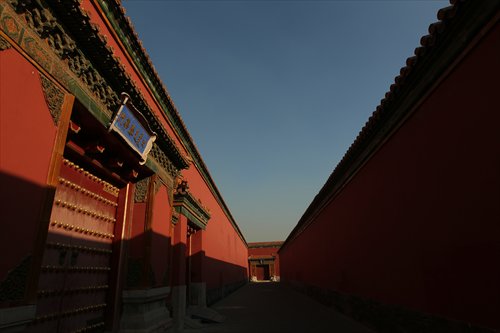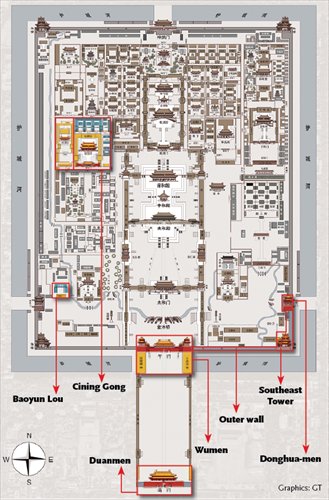Palace Museum’s efforts to rejuvenate the Forbidden City

A corridor in the Palace Museum Photo: Cui Meng/GT

Inset: A map of the Palace Museum
The Palace Museum, located in Beijing's Forbidden City, has once again successfully grabbed the attention of young people in China with a new video that has gone viral on social networks.
In the video, a Ming Dynasty (1368-1644) Emperor walks out of a picture and starts rapping about his life while wearing a big gold necklace and sunglasses.
The video is an advertisement for the new "Tencent NEXT IDEA X The Palace Museum" project, a competition jointly organized by Tencent and the Palace Museum that seeks to encourage young talents to submit their creative ideas for rejuvenating the Forbidden City.
The Internet and digital technology has greatly changed the Palace Museum in recent years. The museum has produced apps aimed at adults and children, while famous artworks such as Night Revels of Han Xizai and Twelve Beauties of Yinzhen have been successfully digitized and made available online.
According to the museum, its cooperation with Tencent will focus on creating emojis for social network applications, and video games based around the culture of the Forbidden City.
Right before announcing its cooperation with Tencent, the Palace Museum revealed it was also working with the Alibaba Group. The museum now has an official store on Alibaba's e-commerce platform Tmall, where museum souvenirs, e-tickets and books can be purchased.
The efforts of the Palace Museum to expand its influence has been increasing in recent years. Its new and creative souvenirs, apps and digital gallery project have all become sensations among younger generations.
The 600-year old Forbidden City, which served as the palace for the royal families of the Ming and Qing (1644-1911) dynasties, is the largest wooden palace complex in China and also home to one of the world's largest collections of antiques from ancient China.
According to Palace Museum Director Shan Jixiang, the museum is looking to ensure the future of the Forbidden City for the next 600 years.
No longer forbidden
In addition to the museum's digitalization efforts, it has also been working to bring in more visitors by opening up more areas to the public.
Located in the center of Beijing, the Forbidden City measures 720,000 square meters in total, with buildings - more than 70 palaces of different sizes and 9,000 other buildings - taking up more than 150,000 square meters of space.
Previously, however, only 52 percent of the complex was open to the public.
Last October the museum celebrated its 90th anniversary by opening up several new areas to the public for the first time ever, including Cining Gong (Palace of Compassion and Tranquility), Shoukang Gong (Palace of Longevity and Health) and the wings of Wumen (Meridian Gate). With these additions, 65 percent of the museum is now open to the public.
Shan said that the museum will open three more areas by the end of the year, which will further increase public areas to 76 percent, while the final goal is to eventually reach 85 percent.
Highlights
Cining Gong
This is probably the most interesting part of the newly opened areas for lovers of movies and TV shows as it has been portrayed in various period films and TV series. It served as the living quarters for the emperor's concubines, but now it serves as an exhibition hall for more than 400 sculptures.
Shoukang Gong
Just next to Cining Gong, this palace was built by the Qianlong Emperor in 1736 as a residence for his mother Empress Xiaoshengxian. It rose to fame by appearing in the sensational TV series The Legend of Zhenhuan, a fictional account of Empress Xiaoshengxian's life.
Donghuamen
(East Prosperity Gate)
After visiting Wumen, visitors can walk on top of the outside wall of the Forbidden City to this gate located in the east wall in the southeast part of the museum. A nearby tower in the southeast corner of the Forbidden City has also been opened to the public.
Duanmen
Gate of Correct Deportment
As this is the main gate all visitors to the museum must first enter, it is the first sight visitors get of the Palace Museum. It currently serves as the exhibition area for the museum's Digital Gallery, where visitors can see the results of its digitization efforts.
Newspaper headline: Bringing the past into the future